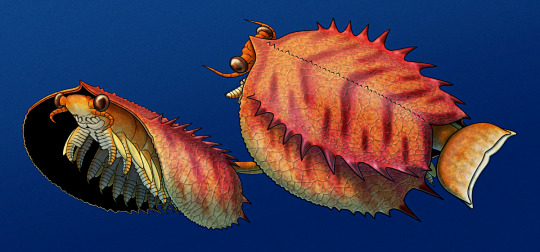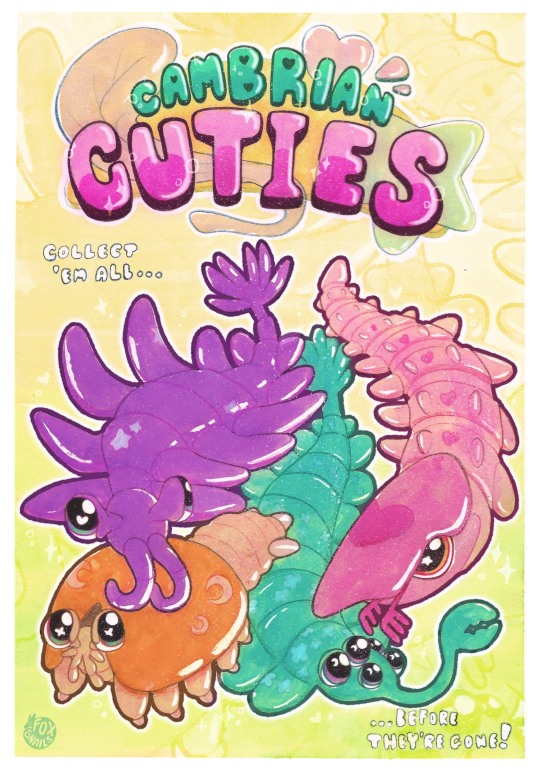#hymenocarina
Explore tagged Tumblr posts
Text

The tuzoiids were an enigmatic group of Cambrian invertebrates known mostly just from their spiny bivalved carapaces. Although hundreds of fossils of these arthropods were discovered over the last century or so, only vague fragments of the rest of their bodies have been found even in sites usually known for preserving soft tissue impressions.
…Until late 2022, when several new specimens from the Canadian Burgess Shale deposits (~508 million years ago) were described showing tuzoiid anatomy in exceptional detail, finally giving us an idea of what they looked like and where they fit into the early arthropod evolutionary tree.
Tuzoiids like Tuzoia burgessensis here would have grown up to about 23cm long (~9"). They had large eyes on short stalks, a pair of simple antennae, a horizontal fluke-like tail fan, and twelve pairs of appendages along their body – with the front two pairs at the head end being significantly spinier, and most (or all) of these limbs also bearing paddle-like exopods.
The large carapace enclosed most of the body, and was ornamented with protective spines and a net-like surface pattern that probably increased the strength of the relatively thin chitinous structure.
Together all these anatomical features now indicate that tuzoiids were early mandibulates (part of the lineage including modern myriapods, crustaceans, and insects), and were probably very closely related to the hymenocarines.
Tuzoiids seem to have been active swimmers that probably cruised around just above the seafloor, with their stout legs suggesting they could also walk around if they flexed their valves open. The arrangement of their spiny front limbs wasn't suited to grabbing at fast-swimming prey, but instead may have been used to capture slower seafloor animals or to scavenge from carcasses.
———
NixIllustration.com | Tumblr | Twitter | Patreon
#science illustration#paleontology#paleoart#palaeoblr#tuzoia#tuzoiidae#hymenocarina#mandibulata#arthropod#invertebrate#cambrian explosion#art#MYSTERY TACO
2K notes
·
View notes
Text
[Image description: An art piece of four Cambrian arthropods — Anomalocaris, Aegirocassis, Waptia, and Opabinia — stylized similarly to Littlest Pet Shop toys, with bright colours, rounded shiny shapes, and large eyes with highlights.
The Anomalocaris is purple with little star markings, and has teal eyes with heart-shaped highlights. The Aegirocassis is pink with little heart markings, and has orange eyes (only one visible) with a star-shaped highlight. The Waptia is orange with crescent markings, and has teal eyes with four-petal flower-shaped highlights. Finally, the Opabinia is teal with four-petal flower markings, and has purple eyes with crescent highlights.
The words “CAMBRIAN CUTIES” are written above them in shiny teal and pink letters. In smaller white letters to the upper left and lower right is a tagline: “Collect Em All… …Before They’re Gone!”
End ID.]

Remember these guys? I had the whole collection back in 538 Million BC 💜🦑
#paleontology#Paleozoic#Cambrian#animals#arthropods#dinocarids#Radiodonta#Opabiniidae#Hymenocarina#Anomalocaris#Aegirocassis#Waptia#Opabinia#cute#cool art
3K notes
·
View notes
Text







Waptia fieldensis
(temporal range: 510-505 mio. years ago)
[text from the Wikipedia article, see also link above]
Waptia is an extinct genus of arthropod from the Middle Cambrian of North America. It grew to a length of 6.65 cm (3 in), and had a large bivalved carapace and a segmented body terminating into a pair of tail flaps. It was an active swimmer and likely a predator of soft-bodied prey. It is also one of the oldest animals with direct evidence of brood care. Waptia fieldensis is the only species classified under the genus Waptia, and is known from the Burgess Shale Lagerstätte of British Columbia, Canada. Specimens of Waptia are also known from the Spence Shale of Utah, United States.
Based on the number of individuals, Waptia fieldensis is the third most abundant arthropod from the Burgess Shale Formation, with thousands of specimens collected. It was among the first fossils found by the American paleontologist Charles D. Walcott in 1909. He described it in 1912 and named it after two mountains near the discovery site – Wapta Mountain and Mount Field, other specimens
Although it bears a remarkable resemblance to modern crustaceans, its taxonomic affinities were long unclear. A comprehensive redescription published 2018 classified it a member of Hymenocarina (which contains numerous other bivalved arthropods) within Mandibulata.
9 notes
·
View notes
Photo


Cambrian Explosion #58: Hymenocarina
The pancrustaceans are a grouping of mandibulates that contains all of the crustaceans and hexapods (insects and their closest relatives) along with their various stem-relatives.
They're critical components of most ecosystems on the planet, and are major parts of the nutrient cycle. In aquatic environments the crustaceans dominate, with modern copepods and krill being some of the most abundant living animals and making up enormous amounts of biomass providing vital food sources for larger animals. On the land springtails and ants are especially numerous, and the air is full of flying insects, the only invertebrates to ever develop powered flight. Some groups of insects have also co-evolved complex mutualistic partnerships with flowering plants and fungi.
Hexapods and insects don't appear in the fossil record until the early Devonian, but they're estimated to have first diverged from the crustaceans* in the early Silurian (~440 million years ago), around the same time that vascular plants were colonizing the land.
(* Hexapods are crustaceans in the same sort of way that birds are dinosaurs. They originated from within one of the major crustacean lineages with their closest living relatives possibly being the enigmatic remipedes.)
But crustaceans and their pancrustacean ancestors go back much further into the Cambrian, and we'll be finishing off this month and this series with some of those early representatives.
———
Some of the earliest known pancrustaceans were the hymenocarines, a lineage of superficially shrimp-like mandibulates with a bivalved carapace covering their head and thorax. Although known only from the Cambrian, they were a diverse group during their existence and were some of the most abundant arthropods in some fossil sites.
Sometimes they're considered to be early or stem-mandibulates, branching off before the euthycarcinoids and the myriapod lineage, but generally they're placed as some of the earliest known pancrustaceans – and Ercaicunia multinodosa helps support that idea.
Known from the Chinese Chengjiang fossil deposits (~518 million years ago), Ercaicunia was about 1.1cm long (~0.4"). Micro-CT scanning of some of its tiny fossils has revealed much of its anatomy in high detail, showing features that identify it as one of the earliest known pancrustacean fossils – and the earliest that isn't microscopic.
It was either part of an early branch of the hymenocarines, or alternatively wasn't quite an actual hymenocarine itself, possibly being a very close relative or stem-member of their lineage.
It had a pair of large oval valves forming a carapace around the front of its body, with its long limbless abdomen and tail fan extending out the back. There were 16 pairs of biramous limbs on its thorax and several pairs of small spines on its back, and its head bore two pairs of antennae – one large pair in front and another much smaller pair hidden under its carapace – along with a pair of mandibles and maxilluae.
It also doesn't seem to have had any eyes, suggesting it had some sort of lifestyle where vision wasn't much use. Its mouthparts also indicate it was probably feeding on something that required manipulation and chewing up, but details of its diet and ecology are still poorly understood.
———
Fibulacaris nereidis was one of the more unusual hymenocarines, known from the Canadian Burgess Shale deposits (~508 million years ago).
Up to 2cm long (0.8"), its narrow keeled carapace had a long backwards-pointing spine, with the front of its body curling over completely in a U-bend so that its head also faced backwards. It had stalked eyes, no obvious antennae or mandibles, and around 40 pairs of limbs running all the way along to its tail fan, indicating it had either a very short or a non-existent abdominal region.
It was probably a filter-feeder, using the shape of its carapace and the beating of its many legs to create a current drawing plankton and suspended organic particles towards its mouth. The combination of this lifestyle and its unusual anatomy suggests it probably swam around upside down, similar to some modern crustaceans like fairy shrimp.
———
Nix Illustration | Tumblr | Twitter | Patreon
#science illustration#paleontology#paleoart#palaeoblr#cambrian explosion#cambrian explosion 2021#rise of the arthropods#ercaicunia#fibulacaris#hymenocarina#pancrustacea#mandibulata#euarthropoda#arthropod#panarthropoda#ecdysozoa#protostome#bilateria#eumetazoa#animalia#art
90 notes
·
View notes